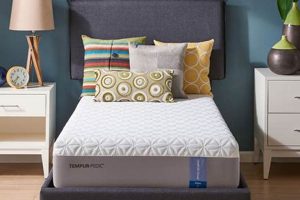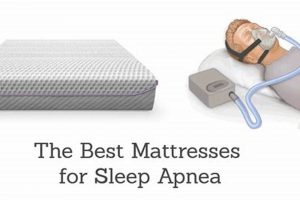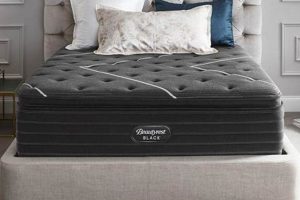A sleeping surface that accommodates various sleep positions, such as side, back, and stomach, is essential for those who change positions throughout the night. These individuals require a mattress that offers a balance of support and pressure relief to ensure proper spinal alignment and comfort, regardless of the chosen position. For example, a medium-firm mattress often strikes a suitable balance, providing adequate support for back and stomach sleeping while still offering enough cushioning for side sleeping.
Selecting an appropriate sleeping surface is important for sleep quality and overall well-being. A mattress that adapts to different sleep postures can reduce pressure points, minimize motion transfer, and promote a more restful sleep experience. Historically, mattresses were designed with a single dominant sleep position in mind, but modern designs increasingly focus on versatility to accommodate a wider range of needs and preferences.
Understanding the specific characteristics of different mattress types, such as innerspring, memory foam, latex, and hybrid models, is crucial when selecting an option. Evaluating factors like firmness level, construction materials, and cooling properties allows individuals to make an informed decision based on their unique sleep requirements and preferences.
Guidance on Mattress Selection
Selecting an appropriate sleeping surface requires careful consideration of various factors to ensure optimal comfort and support.
Tip 1: Assess Sleep Position Frequency. Identify the most frequently assumed sleep positions throughout the night. Understanding this pattern helps narrow down suitable mattress types and firmness levels.
Tip 2: Prioritize Spinal Alignment. Ensure the chosen mattress promotes proper spinal alignment in all sleep positions. A neutral spine reduces pressure on joints and minimizes discomfort.
Tip 3: Consider Mattress Firmness. A medium-firm mattress often provides a balanced combination of support and pressure relief suitable for varied sleep positions. Adjust firmness based on individual weight and comfort preferences.
Tip 4: Evaluate Material Composition. Explore different mattress materials, such as memory foam, latex, innerspring, or hybrid combinations. Each material offers unique properties regarding support, contouring, and temperature regulation.
Tip 5: Examine Motion Isolation. If sharing a bed, prioritize motion isolation to minimize disturbances from a partner’s movements. Memory foam and pocketed coil systems often excel in motion isolation.
Tip 6: Investigate Cooling Properties. Look for mattresses with cooling technologies, such as gel-infused foam or breathable fabrics, to regulate temperature and prevent overheating during sleep.
Tip 7: Review Warranty and Trial Period. Ensure the mattress comes with a sufficient warranty and trial period to allow for thorough testing and evaluation of comfort and suitability.
Following these guidelines provides a structured approach to finding a sleeping surface that accommodates varied sleep styles.
Adhering to the recommendations herein will facilitate a more informed purchasing decision, increasing the likelihood of achieving restful and restorative sleep.
1. Responsiveness
Responsiveness, in the context of selecting a sleeping surface, refers to the mattress’s ability to quickly adjust to changes in pressure and position. For individuals who shift frequently during sleep, this characteristic is paramount. A mattress that lacks responsiveness can hinder movement and disrupt sleep cycles.
- Facilitating Movement
A responsive mattress allows for seamless transitions between sleep positions. A surface that quickly adapts reduces the effort required to change from side to back or stomach. Without sufficient responsiveness, individuals may experience a feeling of being “stuck” in one position, leading to discomfort and fragmented sleep.
- Maintaining Support
Responsiveness ensures consistent support as weight distribution shifts. When a sleeper changes position, the mattress must quickly conform to the new contours to maintain proper spinal alignment. Delayed response can create pressure points and compromise support, resulting in aches and pains.
- Enhancing Comfort
A responsive surface contributes to overall comfort by minimizing the feeling of sinking too deeply into the mattress. This is particularly important for individuals who sleep on their stomach, as excessive sinking can lead to lower back strain. A responsive mattress provides a more buoyant and supportive feel.
- Material Considerations
Certain mattress materials are inherently more responsive than others. Latex, for example, is known for its immediate bounce-back and adaptability. Innerspring mattresses, particularly those with individually wrapped coils, also offer good responsiveness. Memory foam, while excellent for pressure relief, may have slower response times compared to latex or innerspring options. A hybrid mattress can blend these properties for a balance of pressure relief and responsiveness.
The degree of responsiveness directly impacts sleep quality for individuals who change positions. Selecting a mattress with sufficient responsiveness is crucial for minimizing sleep disruptions, maintaining spinal alignment, and promoting overall comfort throughout the night.
2. Spinal alignment
Maintaining proper spinal alignment during sleep is crucial for musculoskeletal health and overall well-being. The connection between spinal alignment and selecting an appropriate sleeping surface is particularly significant for individuals who adopt multiple sleeping positions. A mattress failing to provide adequate support can lead to spinal misalignment, resulting in back pain, neck stiffness, and potentially long-term postural issues. For example, a mattress that is too soft may cause the spine to curve unnaturally when lying on the back or stomach, while a mattress that is too firm may create excessive pressure points, hindering proper alignment when side sleeping.
A sleeping surface designed to accommodate various sleep positions often incorporates zoned support systems. These systems provide targeted support to different areas of the body, ensuring the spine remains in a neutral position regardless of whether the individual is lying on their back, side, or stomach. For instance, a mattress with firmer support in the lumbar region can help prevent spinal sagging when back sleeping, while a softer shoulder zone can alleviate pressure when side sleeping. Proper spinal alignment is a critical component, influencing comfort, reducing pain, and promoting restful sleep.
In conclusion, prioritizing spinal ali
gnment is paramount when selecting a mattress intended for multiple sleep positions. Mattresses that incorporate features such as zoned support and adaptable materials contribute to maintaining a healthy spinal posture. Addressing spinal alignment is not merely a matter of comfort; it is an investment in long-term musculoskeletal health and sleep quality.
3. Pressure relief
Pressure relief refers to a mattress’s capacity to minimize concentrated force on specific areas of the body, such as the shoulders, hips, and knees. For individuals who change sleep positions frequently, this characteristic is particularly critical. Inadequate pressure relief can lead to the development of pressure points, causing discomfort, pain, and disrupted sleep. This is because when the body is subjected to prolonged pressure, blood flow to the affected area is restricted, triggering discomfort signals that can rouse a sleeper from deeper sleep stages. A well-designed sleeping surface should evenly distribute body weight to mitigate these localized pressures. For instance, a side sleeper experiences significant pressure on the shoulder and hip; a mattress offering targeted pressure relief in these areas can prevent discomfort and promote proper spinal alignment. In contrast, a back sleeper benefits from pressure relief along the spine to maintain its natural curvature.
The material composition of a mattress significantly influences its pressure-relieving capabilities. Memory foam, for example, conforms closely to the body’s contours, effectively distributing weight and reducing pressure points. Latex, similarly, offers cushioning and support while maintaining a degree of responsiveness. Hybrid mattresses, which combine elements of innerspring and foam construction, can provide a balance of support and pressure relief. The arrangement and density of coils in an innerspring mattress also play a role in distributing weight and alleviating pressure. Individuals seeking optimal pressure relief should consider mattresses with multiple layers of foam or strategically placed coils that adapt to the body’s shape and movements. A person experiencing hip pain while side sleeping might find that a memory foam mattress topper significantly reduces discomfort by redistributing pressure away from the affected area.
In summary, pressure relief is an indispensable attribute of any mattress designed for multiple sleeping positions. By minimizing pressure points and promoting even weight distribution, a mattress that prioritizes pressure relief contributes to enhanced comfort, reduced pain, and improved sleep quality. The selection of materials and construction techniques directly impacts a mattress’s capacity to provide adequate pressure relief, making it a key consideration in choosing a sleeping surface that accommodates changing sleep postures. Without sufficient pressure relief, even the most supportive mattress may fail to deliver a restful night’s sleep.
4. Motion isolation
Motion isolation, a critical consideration in mattress selection, refers to a sleeping surface’s ability to minimize the transfer of movement from one area to another. This attribute is especially relevant for individuals who share a bed, or those who change positions frequently throughout the night. A mattress with poor motion isolation can disrupt sleep cycles, leading to restless nights and reduced overall sleep quality.
- Minimizing Partner Disturbance
The primary role of motion isolation is to prevent one sleeper’s movements from disturbing their partner. When one person tosses and turns, gets in or out of bed, a mattress with good motion isolation will absorb the movement, preventing it from rippling across the surface and waking the other sleeper. This is particularly important for light sleepers or those with different sleep schedules. For instance, a new parent frequently getting up during the night benefits greatly from a mattress that isolates motion, preventing disturbance to their sleeping partner.
- Material Composition and Motion Transfer
The materials used in mattress construction directly impact motion isolation. Memory foam and latex mattresses are known for their superior motion isolation properties, as they tend to absorb movement rather than transfer it. In contrast, traditional innerspring mattresses often exhibit higher motion transfer due to the interconnected coils. Hybrid mattresses, combining elements of both foam and coils, can offer a compromise, though the specific construction will determine the degree of motion isolation. Mattresses with individually wrapped coils (pocketed coils) generally perform better in terms of motion isolation compared to those with interconnected coils.
- Construction Techniques and Layering
Beyond the core materials, mattress construction techniques play a significant role in motion isolation. Mattresses with multiple layers of foam, particularly those with high-density foam in the comfort layers, tend to provide better motion isolation. The way these layers are arranged and bonded together can further enhance this effect. Some mattresses incorporate specific design features, such as specialized isolation layers, to minimize motion transfer. For example, a mattress might have a layer of viscoelastic foam strategically placed between the coil system and the comfort layers to dampen movement.
- Firmness and Motion Isolation
While material composition is a primary factor, mattress firmness can also influence motion isolation. Generally, softer mattresses tend to isolate motion better than firmer mattresses. This is because softer surfaces conform more readily to the body’s contours, absorbing movement rather than transmitting it across the surface. However, excessively soft mattresses may lack adequate support for some individuals. Therefore, a balance between firmness and motion isolation is often desirable, particularly for those who require both support and minimal disturbance. This is an especially important consideration for combination sleepers.
The discussed properties of motion isolation and its dependecies relate to the overall sleeping experience. A greater awareness of its relevance helps make better purchasing decisions.
5. Edge Support
Edge support is a critical feature that significantly impacts the functionality and overall satisfaction of a sleeping surface, particularly for those who change positions during sleep or share a bed. It refers to the structural reinforcement along the perimeter of a mattress, designed to prevent sagging and maintain consistent support across the entire surface.
- Maximizing Usable Surface Area
Enhanced edge support maximizes the usable sleeping area of a mattress. Individuals who sleep near the edge, or those who spread out during sleep, benefit from a stable perimeter that prevents them from feeling like they might roll off. For example, a couple sharing a queen-sized bed will appreciate the additional usable space provided by strong edge support, as it allows them to sleep comfortably without encroaching on each other’s space.
- Facilitating Ease of Entry and Exit
Solid edge support
provides a stable surface for sitting on the edge of the bed, making it easier to get in and out. This is particularly important for individuals with mobility issues or those who prefer to sit on the edge while dressing. A mattress with weak edge support can make these actions difficult and potentially unsafe. - Enhancing Overall Mattress Durability
Reinforced edges contribute to the long-term durability and structural integrity of the mattress. By preventing sagging and deformation along the perimeter, edge support helps maintain the mattress’s shape and supportiveness over time. This can extend the lifespan of the mattress and ensure consistent comfort for years to come. Mattresses without it will tend to develop a sloped outer rim.
- Supporting Various Sleep Positions
Adequate edge support ensures consistent support regardless of sleep position. For individuals who change positions throughout the night, a stable edge prevents the feeling of rolling off the mattress when sleeping near the perimeter. This is particularly important for side sleepers, who may rely on the edge for support and alignment. It will greatly enhance stability for combination sleepers.
The characteristics of edge support directly influence comfort and functionality. By maximizing usable surface area, facilitating ease of entry and exit, enhancing durability, and supporting various sleep positions, edge support contributes significantly to the overall quality. Ignoring it can cause sagging and negatively impact the sleeping experience.
6. Temperature regulation
Temperature regulation in a sleeping surface is a key factor, directly impacting sleep quality, especially for individuals who change positions throughout the night. A mattress’s capacity to dissipate heat and maintain a comfortable sleep temperature is crucial for preventing sleep disruptions and promoting restorative rest.
- Material Breathability
The breathability of mattress materials significantly influences temperature regulation. Materials like open-cell memory foam, latex, and natural fibers such as cotton and wool allow for greater airflow, facilitating heat dissipation. Conversely, dense, closed-cell foams can trap heat, leading to discomfort. For example, a mattress with a wool cover and a latex core offers superior breathability compared to a traditional memory foam mattress, promoting a cooler sleep environment. Airflow prevents night sweats.
- Cooling Technologies
Mattress manufacturers often incorporate cooling technologies to enhance temperature regulation. These technologies include gel-infused foams, phase change materials (PCMs), and ventilated designs. Gel-infused foam is designed to draw heat away from the body, while PCMs absorb and release heat to maintain a consistent temperature. Ventilated designs promote airflow through the mattress, further aiding in heat dissipation. An example is a mattress with gel-infused memory foam and a PCM cover, which provides enhanced cooling compared to a standard memory foam mattress. Without these, sleepers would overheat faster.
- Construction and Airflow
The construction of a mattress can significantly impact airflow and temperature regulation. Hybrid mattresses, which combine coils and foam, often offer better airflow than all-foam mattresses due to the open space between the coils. The coil system allows for greater ventilation, preventing heat from accumulating within the mattress. For instance, a hybrid mattress with pocketed coils and a breathable cover provides superior airflow compared to an all-memory foam mattress, contributing to a cooler sleep experience. Poor ventilation will make the sleeper toss and turn at night.
- Impact on Sleep Quality
Effective temperature regulation directly influences sleep quality by preventing overheating and maintaining a comfortable sleep environment. When a sleeper becomes too hot, the body’s natural cooling mechanisms can be disrupted, leading to restless sleep, frequent awakenings, and reduced time spent in deep sleep stages. A mattress that effectively regulates temperature can minimize these disruptions, promoting more restful and restorative sleep. Therefore, temperature control enhances rest.
Effective temperature regulation is a key consideration, directly impacting the quality of sleep. Selecting a mattress designed with breathable materials, cooling technologies, and construction techniques that promote airflow is paramount for ensuring a comfortable sleep temperature and preventing sleep disturbances.
7. Material durability
Material durability, referring to a mattress’s capacity to withstand wear and tear over an extended period, is a fundamental attribute contributing to the value of a sleeping surface. For combination sleepers, who exert variable pressure across the mattress due to changing positions, material durability is of particular importance. A mattress constructed from substandard materials will degrade more rapidly, leading to sagging, loss of support, and compromised comfort. These effects can directly counteract the benefits of features designed to accommodate multiple sleep positions, rendering the mattress ineffective over time. As an example, a memory foam mattress with low-density foam may initially provide adequate pressure relief, but will quickly develop impressions and lose its ability to conform to the body’s changing contours. This degradation forces premature replacement and reduced sleep quality.
The selection of durable materials, such as high-density foams, robust coil systems, and reinforced edge support, directly influences a mattress’s lifespan and performance. Mattresses incorporating these elements are better equipped to withstand the constant shifting and pressure associated with combination sleeping. Furthermore, the quality of construction techniques, including the stitching, bonding, and layering of materials, contributes significantly to overall durability. A poorly constructed mattress may exhibit premature separation of layers, leading to uneven support and a compromised sleep surface. For instance, a hybrid mattress utilizing low-gauge coils will likely lose its supportive properties more rapidly compared to one constructed with high-gauge, tempered steel coils, reducing its utility for combination sleepers seeking consistent support regardless of position.
In conclusion, material durability is not merely a desirable attribute but a critical determinant of long-term satisfaction, specifically for those with variable sleeping habits. Investing in a mattress constructed from high-quality, durable materials ensures consistent support, comfort, and performance over an extended lifespan, ultimately delivering superior value and promoting restful sleep. The practical implications of understanding and prioritizing material durability translate to a more economical and comfortable sleep experience for combination sleepers. Failure to address this element undermines features intended to accommodate various positions.
Frequently Asked Questions
The following section addresses common inquiries regarding mattresses designed for individuals who change positions throughout the night. These questions aim to clarify key considerations and provide guidance for informed decision-making.
Question 1: What firmness level is
generally recommended?
A medium-firm mattress is often advised. This firmness level typically offers a balance of support for back and stomach sleeping, while also providing sufficient cushioning for side sleeping. Individual preferences and body weight may necessitate adjustments to this general recommendation.
Question 2: Are hybrid mattresses suitable?
Hybrid mattresses, combining the support of innerspring coils with the pressure relief of foam layers, can be well-suited. These mattresses often provide a versatile sleep surface that accommodates different positions. Assessing the specific coil system and foam density is crucial.
Question 3: How important is motion isolation?
Motion isolation is particularly important for individuals sharing a bed. Mattresses with good motion isolation minimize the transfer of movement, preventing disturbances when a partner changes position. Memory foam and pocketed coil systems often excel in motion isolation.
Question 4: What role does spinal alignment play?
Maintaining proper spinal alignment is crucial regardless of sleep position. The mattress should support the natural curvature of the spine, preventing pressure points and promoting comfort. Mattresses with zoned support can provide targeted support to different areas of the body.
Question 5: How does temperature regulation factor in?
Temperature regulation is significant for preventing overheating and maintaining a comfortable sleep environment. Mattresses with breathable materials, cooling technologies, and designs that promote airflow can help regulate temperature throughout the night.
Question 6: What is the significance of edge support?
Edge support maximizes the usable surface area of the mattress and provides a stable surface for sitting on the edge of the bed. This is particularly important for individuals who sleep near the edge or those with mobility concerns. Strong edge support contributes to overall mattress durability.
In summary, selecting an appropriate mattress involves considering firmness, construction, motion isolation, spinal alignment, temperature regulation, and edge support. These factors collectively contribute to a comfortable and supportive sleep surface.
The next section will cover maintenance and care for mattress of this kind.
Best Mattress for Combination Sleepers
The preceding discussion has illuminated the complexities associated with selecting a sleeping surface optimally suited for individuals who adopt multiple sleep positions. Key considerations include responsiveness, spinal alignment, pressure relief, motion isolation, edge support, temperature regulation, and material durability. Each of these elements plays a crucial role in ensuring a comfortable, supportive, and restorative sleep experience. Neglecting any single factor can compromise the overall effectiveness of the mattress and lead to disrupted sleep patterns.
Ultimately, the choice of the best mattress for combination sleepers represents a significant investment in long-term health and well-being. Individuals are encouraged to carefully evaluate their specific needs and preferences, conduct thorough research, and consider consulting with sleep specialists to make an informed decision. Prioritizing these factors is paramount for achieving consistent and high-quality sleep.




![Top Best Mattress Brands of [Year]: Sleep Soundly! Organic & Natural Mattress Buyer’s Guide: Non-Toxic Sleep Solutions Top Best Mattress Brands of [Year]: Sleep Soundly! | Organic & Natural Mattress Buyer’s Guide: Non-Toxic Sleep Solutions](https://mattressworldpa.com/wp-content/uploads/2025/07/th-7673-300x200.jpg)


